Section #22 - The Southern States secede and the attack on Ft. Sumter signals the start of the Civil War
Aftermath 1861
April 15, 1861
Lincoln Calls For 75,000 Army Volunteers
The Confederates first move is to inform Washington that they intend to leave the Union peacefully and operate henceforth as an independent nation.
But Lincoln will have none of that.
His main concern is that a sovereign South will move immediately to expand slavery into the west and thereby set off a series of battles akin to Bloody Kansas.
He also fears that recognizing the Confederacy as a separate nation will increase the chances of Britain or France providing support for them in a coming civil war.
Finally, in his heart, he is dedicated to ultimately resolving the “house divided” schism and welcoming the southerners back into the “sacred Union” of his youth.
On April 15 Lincoln announces that the rebels are not operating as an independent nation, but rather as “insurrectionists” from within. He says they are illegally violating the 1787 Constitutional “contract” and that his intent going forward will be to compel them to return to the United States proper.
Despite these bold assertions, Lincoln knows that the North is woefully unprepared to prosecute a war.
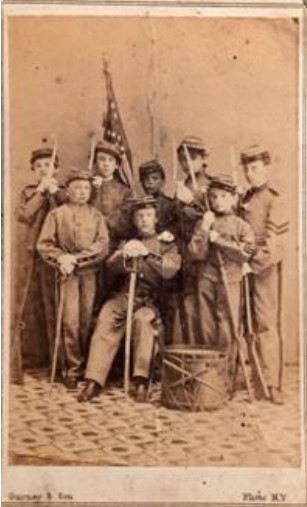
His Regular Army, at the moment, comprises only 16,000 officers and soldiers stationed in small forts across the country and with defections mounting daily from southern supporters. That is hardly enough to conduct a major war, and he acts immediately by calling for 75,000 volunteers to defend the flag.
In doing so, he is initially restrained by the Militia Act of 1795 which puts a ceiling on the number of recruits and limits their service to only three months in total.
Congress, however, quickly overturns the outdated Act and on May 3, Lincoln expands the Regular Army to 22,714 and calls for another 42,000 recruits to serve for three years. In July 1861 the lid comes all the way off with a call for a 500,000 man army.
Estimated Active Troop Sizes During The War
| Time | Union | Confederate |
| Summer 1861 | 200,000 | 200,000 |
| Summer 1863 | 600,000 | 300,000 |
April 17-23, 1861
Virginia Joins The Confederacy Along With R.E. Lee
Lincoln’s call for 75,000 troops is seen as provocative throughout the South — and doubly so since it includes target quotas for all states still in the Union. This includes Virginia and only serves to further enflame the secessionists at the ongoing convention in Richmond. Still the Unionist delegates there warn against a rash move. As Alexander Stuart frames it:
Secession is not only war, but it is emancipation; it is bankruptcy; it is repudiation; it is widespread ruin of our people.
The debate drags on for five days after the fall of Ft. Sumter, with the Unionists trying desperately to prevail. But when their “delay motion” fails by a narrow margin of 64-77, the tide has turned against them. The leader of the war faction continues to be ex-Governor Henry Wise.
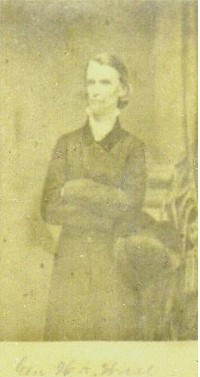
(1806-1876)
Holding a revolver aloft, Wise tells the convention:
We are here indulging in foolish debates, the only result of which must be delay, and, perhaps, ruin. Blood (should) be flowing at Harper’s Ferry before night.
On April 17, the Virginia Ordnance Of Secession passes by a 88-55 votes, and, as Lincoln feared, it will trigger three more states in the Upper South (Arkansas, North Carolina and Tennessee) to also depart.
The Virginia decision fosters one other outcome that will profoundly impact the course of the war. It involves Colonel Robert E. Lee, a 32-year veteran of service in the U.S. Army now forced to make a decision between his loyalty to the United States or to his roots in Virginia.
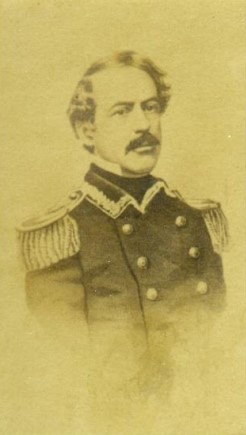
Lee has consistently opposed secession calling it an unlawful “betrayal” and “nothing but revolution.” As recently as March 28, 1861 he swears an oath of loyalty as part of his promotion to Colonel in the Regular Army. But the convention vote changes his mind.
Upon hearing of his wavering, Lincoln’s advisor Francis Preston Blair Sr. approaches Lee and offers him a position as Major General in charge of defending the capital. Lee’s response is telling:
Mr. Blair, I look upon secession as anarchy. If I owned the four millions of slaves in the South I would sacrifice them all to the Union; but how can I draw my sword upon Virginia, my native state?
Most of Lee’s family oppose secession and Lee himself agonizes over his decision before submitting his resignation on April 20 to a despairing Winfield Scott. On April 23, he is given command of all troops in Virginia and on August 31 he is named one of the five initial Lieutenant Generals, ranking third behind Samuel Cooper and Albert Sidney Johnston. Throughout the war, Lee will wear the insignia of a Colonel, refusing to don that of a full general unless and until the war is won.
Sidebar: Reprise Of Slave State Secession Decisions
Out of a total of fifteen slave states in America, eleven will secede, three will remain in the Union, and one (Kentucky) will declare neutrality.
| States | Convention On | Decisions |
| South Carolina | December 20, 1860 | Secedes |
| Mississippi | January 9, 1861 | Secedes |
| Florida | January 10 | Secedes |
| Alabama | January 11 | Secedes |
| Georgia | January 19 | Secedes |
| Louisiana | January 26 | Secedes |
| Texas | February 1 | Secedes |
| Delaware | January 3 | Rejects Secession |
| Missouri | March 19 | Rejects Secession |
| Virginia | April 17 | Secedes |
| Maryland | April 30 | Rejects Secession |
| Arkansas | May 6 | Secedes |
| North Carolina | May 20 | Secedes |
| Kentucky | May 20 | Neutral |
| Tennessee | June 8 | Secedes |
April 19, 1861
Union Troops Attacked In Baltimore
Two days after Virginia secedes, a secessionist mob in Baltimore attacks Union Militia troops as they arrive by rail on their way to defend Washington.

The first soldiers to arrive are a mix of Volunteer companies and Regular from Pennsylvania, who are pelted by bricks and curses as they march through the streets on way to their encampment on April 18 in DC near the Washington monument.
One man injured in the melee is 65-year old Nick Biddle, a beloved black servant in the troop who is given the honor of wearing a uniform of the Washington Artillery. When he is spotted, cries of “Nigger in uniform” go up and he is hit in the head by a stone.
Biddle continues to march, head wrapped in a bloody bandage, and wins subsequent notoriety as the “first casualty of the war.”
The Pennsylvanians are followed by 240 soldiers of the 6th Massachusetts Militia who are met at the Baltimore train station by a mob of some 700 members of the pro-secessionist “National Volunteers.”
A riot breaks out after shots are fired into the crowd and before the fighting ends, four U.S. troops are killed and twenty-four others are wounded. Twelve “Volunteers” also die in the battle.
April 27, 1861
Lincoln Suspends Habeas Corpus To Deal With Rebels
The riot in Baltimore triggers fear that the Slave State of Maryland may secede at its upcoming April 30 convention, and then move to cut off access of Union troops to the capital.
To address this threat, Lincoln decides to authorize the arrest and imprisonment of known insurrectionists and the suspension of their right to habeas corpus (appearing in court to confront one’s accusers).
Included in the initial round up are the Mayor of Baltimore, the Police Chief and entire Board of Police, the City Council members and even sitting U.S. Congressman Henry May.
Critics of this action, notably Chief Justice of the Supreme Court, Roger Taney, regard this as an unconstitutional violation of Article I, Section 9 of the Constitution:
The privilege of the writ of habeas corpus shall not be suspended, unless when in cases of rebellion or invasion the public safety may require it.
On May 25, another arrest is made, this time involving one John Merryman, a member of the Baltimore resistance, who is accused of treason for destroying public property, including strategic bridges around the city. After he is jailed at Ft. McHenry, his lawyers assert the right to habeas corpus, and the case comes before Roger Taney, Chief Justice of the U.S. Supreme Court, acting in his circuit court capacity.
In Ex parte Merryman, Taney issues an order saying that the defendant must be brought to court – but it is ignored by General George Cadwallader at the fort who cites Lincoln’s prior directive.
Lincoln himself also rejects the order before addressing the controversy in a July speech to Congress where he argues that his action is justified by the exception clause for “cases of rebellion.” But then, on July 13, Merryman is released from jail after posting bail of $25,000 and his treason trial is called off.
Still the President continues to demand the arrest of insurrectionists, and in March 1863 Congress passes a bill in support of his policy “whenever the public safety may require it.”
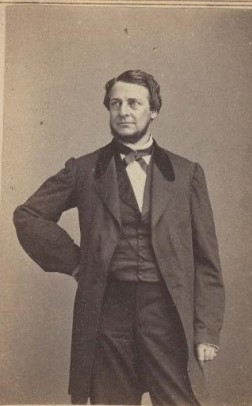
Another famous case follows on May 5, 1863, when ex-Ohio Congressman Clement Vallandigham is taken into custody by General Ambrose Burnside. Four days earlier he delivers an inflammatory speech to a large crowd repeating his claims that the war is being fought by “King Lincoln” to free the slaves not save the Union, that the liberties of white men were at risk and that the slaughter should stop immediately.
A military tribunal sentences Vallandigham to prison for the duration of the war, and he in turn demands his right to habeas corpus in a federal court.
On May 19 Lincoln dodges the legal issue by ordering that the prisoner be escorted through Union lines to reside in the Confederacy. Ironically Jefferson Davis guards him as an “enemy alien” before he leaves the country on a blockade runner, ending up in Canada. From there he successfully campaigns for the Democrat nomination for Governor of Ohio before eventually going down to a 60-40% defeat in the 1863 general election.
April 1861
Scott Launches The Anaconda Plan To Blockade Southern Ports
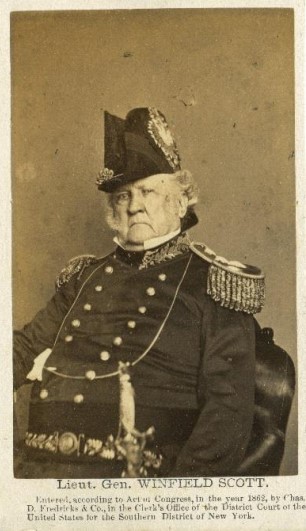
The President turns to his General-in-Chief, Winfield Scott, to plan the Union’s military strategy for the upcoming war.
Unlike those who anticipate a short conflict with the Union racing overland for a mere 200 miles to capture Richmond, Scott foresees a prolonged struggle decided in the end by sieges and attrition.
This leads to his “Anaconda Plan” to produce a stranglehold on the South by utilizing U.S. Navy superiority to encircle and then contract its borders.
Scott’s first blow will lie in blockading all Southern ports, thereby limiting its outgoing commercial ties to Europe along with its hopes for incoming military supplies.
This will be followed by a campaign to drive down the Mississippi River to New Orleans, effectively sealing off the CSA western armies from those in the East.
Once that much is accomplished, the Union’s superior manpower and resources will simply squeeze the life out of the Confederacy.
In the end, despite many stops and starts, Scott’s Anaconda Plan will play out essentially as he predicts.
May 13, 1861
Queen Victoria Declares That Britain Will Remain Neutral
While Scott plans to isolate the South, the CSA government is trying to gain formal recognition of its independent nation status especially from Great Britain, and the potential for military support to follow.
But Lincoln recognizes this threat and acts to shut it down by announcing that any foreign support to the South will be regarded as an act of war against the United States. His blockade of the southern ports signals his willingness to use force against aggressors.
At this point, Britain is on the spot to decide its strategic response. Are the benefits of preserving the supply of raw cotton from the South sufficient to assume the risks of warfare with the Union on the high seas and perhaps even in Canada?
While the common working men in England clearly oppose the Confederates for their reliance on slave labor, many among the upper crust identify with the more aristocratic traditions of the South. Key among them is William Gladstone, Chancellor of the Exchequer, whose family wealth traces to slave labor in the West Indies. Gladstone’s views are offset by Lord John Russell, currently serving as Foreign Minister.
The third man in the mix is “Harry” Temple, Lord Palmerston, who is Prime Minister throughout the American conflict and who finally comes down on the side of caution.
The policy is announced on May 13, 1861 in a “Proclamation of Neutrality” from Queen Victoria, still fairly early on in her 63 year run (1837-1901) on the British throne.
Whereas hostilities have unhappily commenced between the United States and certain States styling themselves as the Confederate States of America…And whereas we being at peace with the Government of the United States, we declare our Royal determination to maintain a strict and impartial neutrality in the contest between said competing parties.
Although France and other foreign powers adopt this same position, many violations will materialize over the course of the four-year war. Britain will end up arming the majority of Southern infantrymen, mainly with Enfield Rifles. “Privateers” from both Britain and France will sail across the Atlantic carrying foodstuffs and weapons, as well as acting as “raiders” destroying over 700 U.S. merchant ships. France also uses the war as a diversion in December 1861 to invade Mexico and install Emperor Maximillian I for a five-year reign.
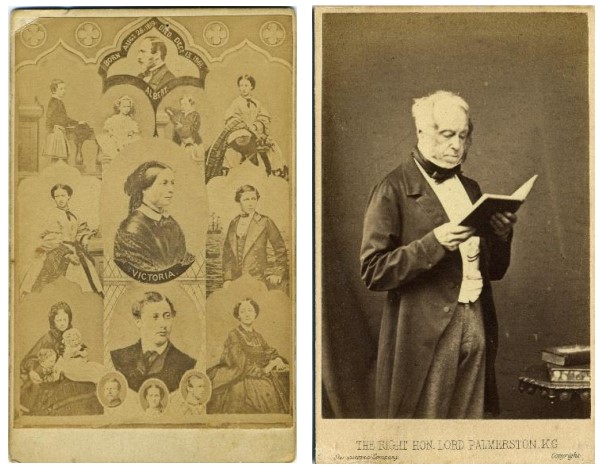
May 24, 1861
A Cold-Blooded Murder Claims The Life Of Col. Elmer Ellsworth
Another violent incident occurs on May 24 in Alexandria, Virginia at the Marshall House Inn.
The proprietor there, a man named James Jackson, raises a large Confederate Flag on the roof of the inn which is spotted by Union troops in the vicinity. They take it upon themselves to haul it down, with Elmer Ellsworth, Colonel of the 11th N.Y. Volunteers (“Fire Zouaves”), and Private Francis Brownell first on the scene.
Ellsworth reaches the roof, tears down the flag and is descending with Brownell to the lobby when Jackson appears on a landing and fires one round from his double-barreled shotgun into the Colonel’s chest, killing him instantly. But before he can shoot again, Brownell kills him with a shot to the face.
Word of the murder spreads rapidly, given Ellsworth’s friendship with Lincoln and the fact that he is the first officer to fall for the Union. His uniformed body is displayed in the East Room of the White House before being moved to City Hall in New York City for a viewing attended by thousands and followed by a state funeral. For his action, Brownell is awarded the Congressional Medal of Honor and becomes a celebrity in the North.
The innkeeper James Jackson is also celebrated across the South as a martyr to its cause.
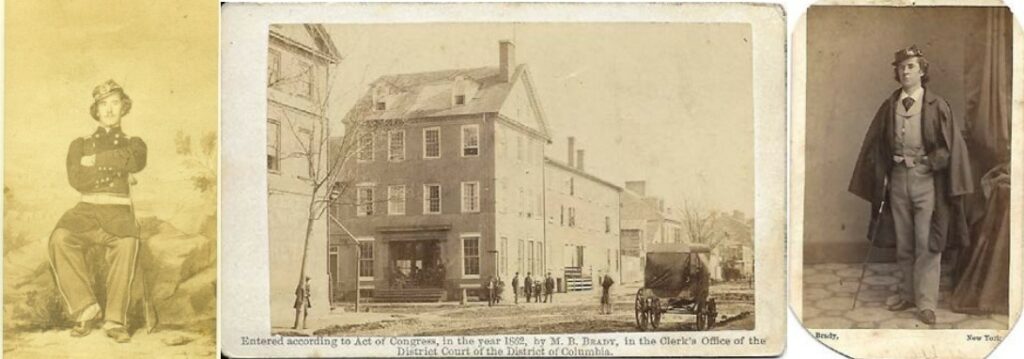
July 21, 1861
The Battle Of 1st Bull Run Foretells The Slaughter To Come
Once it’s clear that a peaceful exit by the Confederates is not to be, both sides begin to organize for the warfare to come.
Soldiers in the Regular Army head North or South and join up with new volunteers. Each is given a rank (from Private to General), assigned to a branch (Infantry, Artillery, and Cavalry) and placed in a unit:
Military Structure With Optimal Troop Levels
| Company Regiment | Brigade | Division | Corps | Army | |
| 100 men | 4 companies | 4 regiments | 3-5 brigades | 3 divisions | 1-8 corps |
| 100 men | 400 men | 1,600 men | 6,000 men | 18,000 men | 70,000 men |
| Captain | Colonel | Brigadier General | Major General | Lt. General |
These units are then allocated to the Easter or Western Theaters of war, and to Departments with defined territorial boundaries. The Union Army tends to name their forces after rivers (e.g. the Army of the Potomac or the Tennessee) while the Confederates prefer state titles (e.g. the Army of Northern Virginia.)
Training is rudimentary on both sides, with Regular Army veterans overseeing basic drills for the raw volunteers.
Actual conflict early on is limited to “skirmishes,” the first of significance on June 3 around Philippi, Virginia, where Major General George McClellan routs a small band of Confederates, earning more credit for command than he deserves and prompting “Drive to Richmond” rhetoric among the northern public.
The pressure to advance falls on Irwin McDowell a former staff officer promoted three ranks to Brigadier General and placed in charge of the 35,000 man Union Army of Northwestern Virginia. On July 16, his troops depart from Washington intent on staging a diversionary attack at Manassas Junction while moving the bulk of his command south to take Richmond.
Meanwhile the Confederate Army of the Potomac under the dashing Brigadier General Pierre Gustav Toutant Beauregard hears of the Union advance from spies in D.C. and moves his force into defensive positions just west of a point where the Warrenton Pike crosses the Manassas Sudley Road.
After a debilitating 30-mile hike in the blistering heat, McDowell shows up east of the Sudley Road on July 18 and begins to deploy his troops for battle. This effort drags on for two days, during which time Beauregard receives additional reinforcements.
Early on the morning of July 21 both armies swing into action, each with roughly 18,000 men who will be actively engaged during the combat. Ironically both commanders have the same plan in mind, that being to strike at their opponent’s left flank and then envelope their rear guards. Thus the battle takes on the form of a counterclockwise wheeling motion, with McDowell heading north and west and Beauregard going south and east.
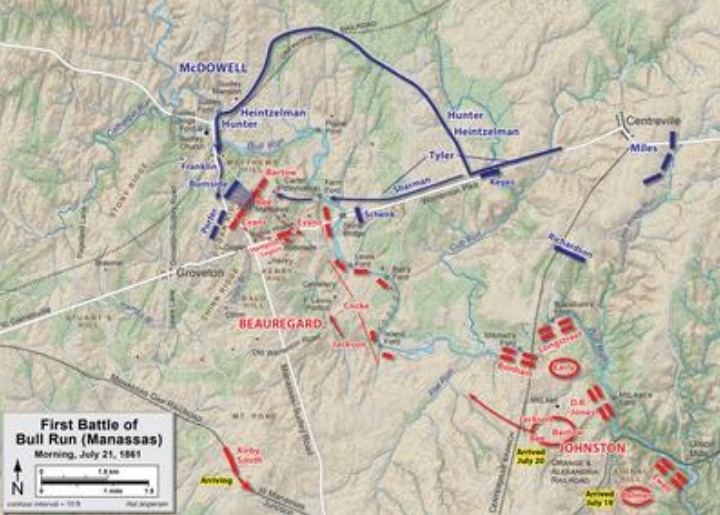
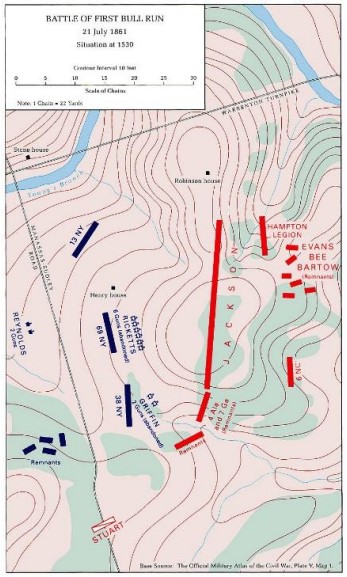
The fighting rages on throughout the day, with the Union enjoying the upper hand.
Then comes the turning point around 3:30pm when the Union’s 1st Artillery unit under Captain James Rickett’s attempts to drive the Confederates off of Henry Hill, just south of the Warrenton pike.
But they are stopped cold by a general who earns a lasting sobriquet from fellow defender Bernard Bee who is heard to say: “there stands Jackson like a stone wall.”
While Bee is mortally wounded, Stonewall Jackson and his fellow Confederates race down from Henry Hill to capture Ricketts’ battery and Ricketts himself, shot four times during the exchange.
At this point the tide has turned against the Union.
Jackson’s troops are soon joined by the main body of the southern army moving in unison against McDowell’s suddenly disheartened brigades just north of the crossroads.
From there the rout is on.
By 5:00pm McDowell’s troops are running away for safety. Most retreat due north along the Manassas-Sudley road then turn east along an unfinished railroad line before looping back to the Warrenton Pike on their way to Washington.
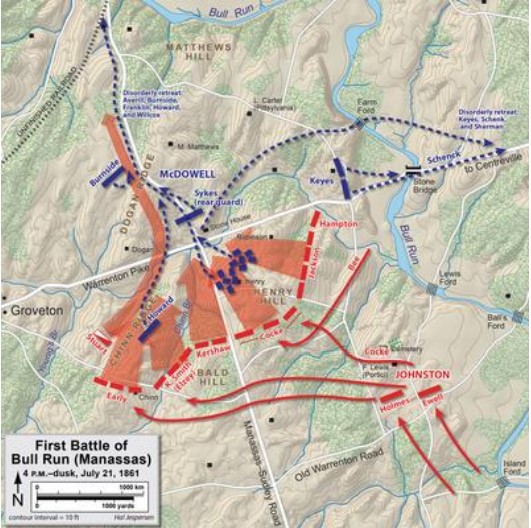
The capital is in a state of shock as stragglers wander in over the next several days. Rumors abound that the rebel army will launch an attack at any minute, but this never materializes. Like the Union troops, the Confederates are totally played out and in no shape for an offensive.
A respite follows, but 1st Bull Run ends the popular myths on both sides about a short war with heroic victories and few casualties. When the muster rolls are called after July 21, nearly 5,000 men have been killed, wounded or captured.
Casualties At First Bull Run
| Union | Confederate | |
| Killed in Action | 460 | 387 |
| Wounded | 1,124 | 1,582 |
| Captured/missing | 1,312 | 13 |
| Total | 2,896 | 1,982 |
Included among those captured during the flight are many northern “spectators” who have shown up with chairs, binoculars and picnic baskets to watch the “entertainment” from afar. One of them is U.S. Congressman Alfred Ely of New York who will spend the next six months in Libby Prison before being released by an exchange of captives.
Of course it is unknown at the time that the butcher bill from July 1 will be exceeded by 30 other encounters over the next four years – with the 51,000 casualties at the three day long Battle at Gettysburg leading the count.
In regard to the total number of victims of the Civil War, new estimates continue to appear as scholars try to reconstruct piecemeal records. The numbers below are now thought to represent the lower end of the range, with some 650,000 killed, missing or dead of disease and another 469,000 wounded.
Casualties During The Entire War
| Union | Confederate | Total | |
| Killed in Action | 110,000 | 94,000 | 204,000 |
| Wounded | 275,000 | 194,000 | 469,000 |
| Captured/missing | 30,000 | 31,000 | 61,000 |
| Died of Diseases | 225,000 | 164,000 | 389,000 |
| Total | 640,000 | 483,000 | 1,123,000 |
Even these conservative estimates are shocking, as the 1.1 million figure represents a full 3% of the nation’s population in the 1860 Census. The casualties during the conflict exceed the cumulative number of losses for all of America’s wars from the 1776 Revolution through the two World Wars, Korea, Viet Nam and the Middle East.
The financial costs are also staggering, with total estimates around $6Billion for the North and $3Billion for the South. Despite the imposition of the first tax on personal income (prohibited in the 1787 Constitution) both sides are bankrupt as the war ends.
Finally, with the South employing a largely defensive posture to survive, it suffers a devastating loss of property and infrastructure and cities, not to mention the trauma endured by its civilian population.

Summary Of Key Events In 1861 After The Fall Of Ft. Sumter
| Date | Events |
| April 15 | Lincoln declares a state of “insurrection” (not war) and calls for 75,000 volunteers to serve for three months. |
| April 17 | Virginia becomes the 8th state to secede |
| April 19 | A secessionist mob in Baltimore attacks Union troops, killing four. Lincoln orders a blockade of Southern ports according to Anaconda. |
| April 19 | The Anaconda Plan to block Southern ports goes into effect |
| April 20 | Robert E. Lee resigns his US Army commission and accepts a position with the CSA |
| May 3 | Lincoln expands the Regular Army to 22,714 and calls for an additional 42,000 volunteers to serve for up the 3 years. |
| May 6 | Arkansas secedes |
| May 13 | England proclaims neutrality, soon followed by France and Spain. |
| May 13 | Martial law declared in Baltimore by General Ben Butler |
| May 20 | North Carolina secedes |
| May 21 | Richmond named CSA capital |
| May 24 | Col. Elmer Ellsworth killed by a rebel at the Marshall House in Virginia |
| June 3 | Battle of Phillipi, Va. McClellan |
| June 8 | Tenn secedes, 11th and last |
| June 11-19 | Loyalists form a Unionist gov in W. Va |
| July | The Congress authorizes a volunteer army of 500,000 men |
| July 2 | Lincoln authorizes suspension of habeas corpus |
| July 21 | First Bull Run |
| July 22 | U.S. Congress resolution that the war is being fought to “preserve the Union” and not to abolish slavery |
| August 5 | The Congress passes the first personal income tax to help fund the war |
| August 10 | CSA wins Wilson’s Creek battle in Missouri |
| August 30 | General Fremont authorizes martial law in Missouri and “frees” the slaves of secessionists in the state – before Lincoln voids the order. |
| Sept 13 | First naval engagement as US ship raids CSA site in Pensacola and burns a privateer |
| Oct 4 | Authorization of first US armored warship, Monitor. |
| October 21 | CSA wins battle of Ball’s Bluff with 1900 US soldiers killed |
| Nov 1 | Lincoln names George McClellan to replace Scott as General In Chief |
| Nov 7 | Union Navy captures two rebel forts on Port Royal Sound, SC |
| November 8 | Two CSA diplomats on RMS Trent seized by the US Navy sparking a crisis |
| December 8 | Spain invades Mexico leading to the 5.5 year reign of Maximillian I |
| Dec 20 | “Radical Republicans” in Congress set up a Joint Committee on the Conduct of the War to oversee Lincoln who they feel is too conciliatory toward the CSA. |